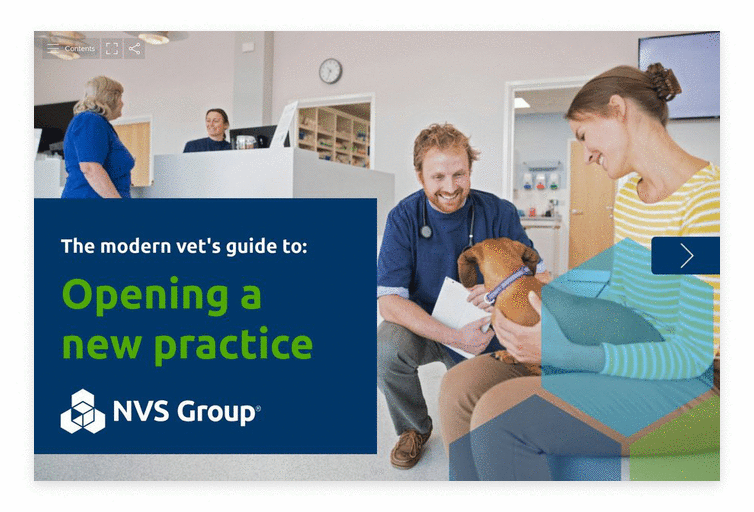
Starting your own veterinary practice is an exciting venture, but to ensure success, it’s crucial to have a clear vision of what you want to achieve and a strategy to get there. From pinpointing your target market to planning the layout and services of your practice, the to-do list may seem overwhelming. However, with the right framework, a clear and actionable plan is within your reach.
Key areas to consider:
Practice ethos and guiding values
Defining your practice’s ethos and guiding values is the cornerstone of establishing a successful veterinary practice. This involves taking a deep dive into what you believe as a veterinarian and how you envision your practice serving the community. Are you committed to advancing veterinary medicine through innovative treatments, or perhaps ensuring accessible and affordable care for all pet owners? Clearly articulating these values not only sets the tone for how your practice will operate but also attracts like-minded clients and staff who share your vision.
Furthermore, these guiding principles will serve as a moral compass, influencing daily decision-making and long-term strategies. From the type of services you offer to the way you interact with clients, your practice ethos will be reflected in every aspect of your operation.
Type of practice
The next step is to specify the type of veterinary practice you intend to establish. Understanding your target niche will inform the training and expertise required for your team, the equipment and facilities you’ll need, and the types of services that will be most beneficial to your client base. Will your focus be on small animals, horses, farm animals or a mixed practice? Perhaps you’re looking for animal-specific or a speciality such as orthopaedics? In addition to deciding on the specialisation, you’ll need to consider your approach. Will you provide services from a static clinic, offer ambulatory care or follow a hybrid approach?
Location and market assessment
Selecting the right location for your practice is a strategic decision with far-reaching consequences. Begin by conducting a market assessment to understand the demand for veterinary services in surrounding areas. Consider demographic factors such as pet ownership rates, average income levels, and local competition. This analysis will help you identify the most promising locations where your services are needed and appreciated, positioning you for sustainable growth.
Moreover, the location should align with your practice ethos and services. For example, a specialised equine practice would need to be positioned in an area with significant horse ownership and activity. Accessibility, visibility, and convenience for clients are also crucial.
Practice building and planning
Once the location is finalised, envisioning the physical layout and design of your practice is the next critical step. A thoughtfully planned practice not only improves operational efficiency but also significantly enhances the client experience. From the reception area to examination rooms and surgical suites, each space should be designed to facilitate seamless workflows while ensuring comfort and ease for both pets and owners. Looking ahead, it’s wise to consider future expansion in your design plans. As your client base grows, additional space for more exam rooms or specialised treatment areas could be essential.
Services
Determining the range of services your practice will offer is crucial for setting your practice apart and meeting the needs of your clients. Will you provide general wellness checkups, vaccinations, dental care, surgery, and emergency services? The breadth of services should be a reflection of both your professional expertise and the needs identified through your market assessment. Offering a comprehensive suite of services can attract a larger client base, providing convenience and building stronger relationships with pet owners.
In parallel, consider integrating specialised services that cater to specific health issues or pet types prevalent in your area. Advanced diagnostics, rehabilitation therapies, or nutritional counselling can enhance your practice’s reputation and differentiate your practice from your competitors.
Retail strategy
Incorporating a retail component into your practice can significantly enhance client satisfaction while generating additional revenue. By offering high-quality pet foods, health supplements, grooming products or accessories, you can create a one-stop shop for pet owners. This convenience can forge stronger client relationships, as pet owners will appreciate the ease of accessing trusted products recommended by their veterinarian.
To maximise the retail strategy’s effectiveness, ensure the products align with your practice ethos and client needs. Consider offering niche products that cater to the specific health concerns and preferences of your clients. Effective merchandising, staff training on product benefits, and integrating retail services into routine consultations can further boost sales and client satisfaction.
To successfully open a new veterinary practice, you need more than just passion—you need a detailed plan. By focusing on these key areas, you can create a clear vision for your practice and set yourself on the path to success.
Read more….
The Modern Vet’s Guide to Opening a New Practice
At NVS Group, we understand the challenges that come with launching a new practice, and that’s why we’ve developed this resource specifically tailored to guide you through the process. An invaluable tool crafted by industry experts, it provides you with essential insights, best practices, and practical tips to ensure your success.





